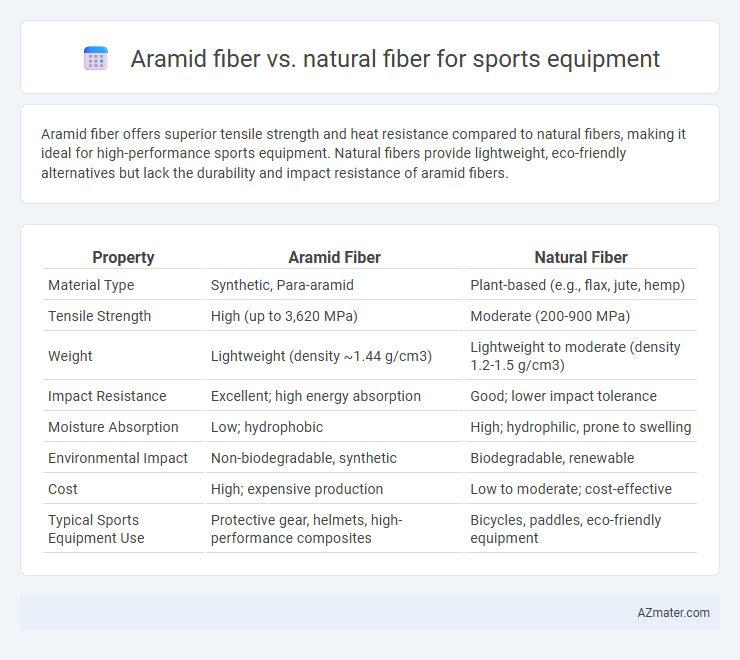Aramid fiber offers superior tensile strength and heat resistance compared to natural fibers, making it ideal for high-performance sports equipment. Natural fibers provide lightweight, eco-friendly alternatives but lack the durability and impact resistance of aramid fibers.
Table of Comparison
| Property | Aramid Fiber | Natural Fiber |
|---|---|---|
| Material Type | Synthetic, Para-aramid | Plant-based (e.g., flax, jute, hemp) |
| Tensile Strength | High (up to 3,620 MPa) | Moderate (200-900 MPa) |
| Weight | Lightweight (density ~1.44 g/cm3) | Lightweight to moderate (density 1.2-1.5 g/cm3) |
| Impact Resistance | Excellent; high energy absorption | Good; lower impact tolerance |
| Moisture Absorption | Low; hydrophobic | High; hydrophilic, prone to swelling |
| Environmental Impact | Non-biodegradable, synthetic | Biodegradable, renewable |
| Cost | High; expensive production | Low to moderate; cost-effective |
| Typical Sports Equipment Use | Protective gear, helmets, high-performance composites | Bicycles, paddles, eco-friendly equipment |
Introduction to Aramid and Natural Fibers in Sports Equipment
Aramid fibers, such as Kevlar, are synthetic fibers known for their exceptional strength-to-weight ratio, high tensile strength, and excellent impact resistance, making them ideal for high-performance sports equipment like helmets and protective gear. Natural fibers, including hemp, flax, and cotton, offer eco-friendly properties, biodegradability, and good vibration damping, commonly used in sports equipment for sustainability and comfort. The choice between aramid fibers and natural fibers depends on the required durability, weight, and environmental considerations in sports gear manufacturing.
Key Properties of Aramid Fibers
Aramid fibers exhibit exceptional tensile strength, high resistance to abrasion, and excellent thermal stability, making them ideal for high-performance sports equipment such as helmets, protective padding, and racket frames. Their lightweight nature enhances durability without compromising flexibility, allowing for improved impact absorption and long-lasting wear under intense physical activity. Compared to natural fibers, aramids provide superior mechanical properties and weather resistance, ensuring consistent performance in demanding sports environments.
Key Properties of Natural Fibers
Natural fibers such as hemp, flax, and jute offer lightweight, biodegradable, and renewable options for sports equipment, providing enhanced breathability and moisture absorption. These fibers exhibit good tensile strength and flexibility, making them suitable for applications where impact resistance and comfort are essential. Their environmental sustainability contrasts with synthetic alternatives like Aramid fibers, which excel in high tensile strength and heat resistance but lack biodegradability.
Strength and Durability Comparison
Aramid fibers, such as Kevlar, offer superior tensile strength and impact resistance compared to natural fibers like cotton or hemp, making them ideal for high-performance sports equipment. The molecular structure of aramid fibers provides exceptional durability, maintaining structural integrity under intense stress and repeated use. Natural fibers, while environmentally friendly, typically exhibit lower strength and degrade faster when exposed to moisture and UV radiation, limiting their lifespan in demanding sports applications.
Weight and Flexibility Factors
Aramid fiber offers superior strength-to-weight ratio compared to natural fibers, making sports equipment lighter and more durable. Its high tensile strength and excellent flexibility enhance performance in gear like helmets and protective pads, where impact resistance and mobility are critical. Natural fibers, while eco-friendly and breathable, generally lack the lightweight flexibility and resilience that aramid fibers provide under strenuous sports conditions.
Environmental Impact and Sustainability
Aramid fiber, known for its exceptional strength and durability, offers a longer lifespan for sports equipment, reducing the frequency of replacement and waste generation. Natural fibers such as hemp and flax are biodegradable and have a lower carbon footprint during production, promoting sustainability and environmental friendliness. While aramid fibers are petroleum-based and less eco-friendly to produce, advancements in recycling methods are improving their environmental impact compared to synthetic alternatives.
Cost Analysis: Aramid vs. Natural Fibers
Aramid fibers, such as Kevlar, offer superior strength-to-weight ratios and durability compared to natural fibers like hemp or flax, but they come at a significantly higher cost, often two to three times more expensive per kilogram. Natural fibers provide a cost-effective, sustainable alternative with adequate performance for lower-end sports equipment, reducing material expenses by up to 50%. The cost analysis favors natural fibers in budget-conscious markets, while aramid fibers justify their premium price through enhanced performance and longevity in high-performance sports gear.
Performance in Different Sports Applications
Aramid fiber exhibits superior tensile strength and impact resistance compared to natural fibers, making it ideal for high-performance sports equipment such as helmets, protective gear, and racquets. Natural fibers offer lightweight and eco-friendly advantages favored in applications like yoga mats and casual sportswear, but they lack the durability and abrasion resistance of aramid fibers. In sports demanding maximal protection and longevity, aramid fiber outperforms natural fibers due to its enhanced mechanical properties and resistance to heat and wear.
Maintenance and Longevity Considerations
Aramid fibers, such as Kevlar, offer superior maintenance advantages over natural fibers due to their resistance to moisture, UV exposure, and chemicals, contributing to extended product lifespan in sports equipment. Natural fibers like cotton and hemp require more frequent care, including drying and protection against mold, which can compromise durability. The inherent strength and abrasion resistance of aramid fibers result in longer-lasting sports gear with minimal upkeep compared to natural fiber counterparts.
Conclusion: Choosing the Right Fiber for Sports Equipment
Aramid fibers offer superior strength, lightweight durability, and excellent resistance to abrasion, making them ideal for high-performance sports equipment such as helmets, racquets, and protective gear. Natural fibers like hemp and flax provide eco-friendly, biodegradable options with good flexibility and impact absorption but lack the high tensile strength of synthetic aramid fibers. Selecting the right fiber depends on prioritizing performance demands versus sustainability goals in sports equipment design.

Infographic: Aramid fiber vs Natural fiber for Sports equipment
 azmater.com
azmater.com